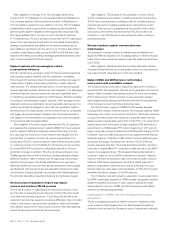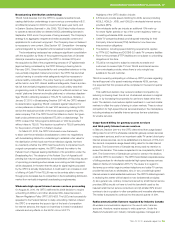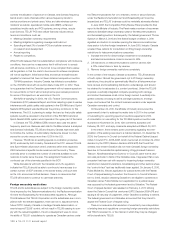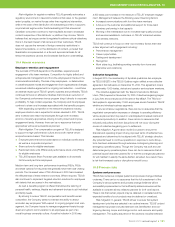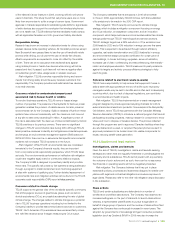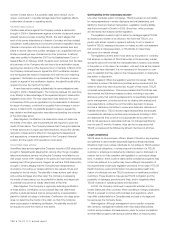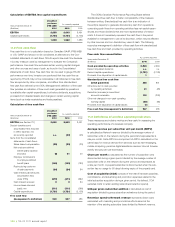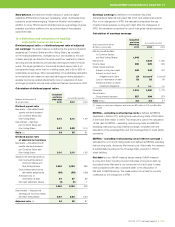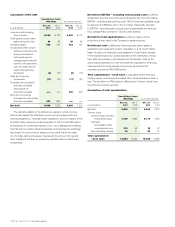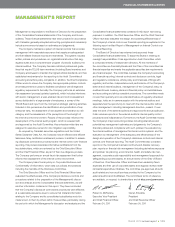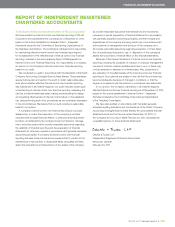Telus 2010 Annual Report Download - page 110
Download and view the complete annual report
Please find page 110 of the 2010 Telus annual report below. You can navigate through the pages in the report by either clicking on the pages listed below, or by using the keyword search tool below to find specific information within the annual report.106 . TELUS 2010 annual report
Civil liability in the secondary market
Like other Canadian public companies, TELUS is subject to civil liability
for misrepresentations in written disclosure and oral statements, and
liability for fraud and market manipulation. Legislation creating liability
was first introduced in Ontario in 2005. Since then, other provinces
and territories have adopted similar legislation.
The legislation creates a right of action for damages against TELUS,
its directors and certain of its officers in the event that TELUS, or a
person with actual, implied or apparent authority to act or speak on
behalf of TELUS, releases a document or makes a public oral statement
that contains a misrepresentation, or TELUS fails to make timely
disclosure of a material change.
The legislation permits action to be taken by any person or company
that acquires or disposes of TELUS securities in the secondary market
during the period of time that the misrepresentation remains uncorrected
in the public or, in the case of an omission, until such time as the material
change has been disclosed. It is not necessary for the person or com-
pany to establish that they relied on the misrepresentation in making the
acquisition or disposition.
Risk mitigation: When the legislation was first introduced, TELUS
conducted a review of its disclosure practices and procedures and the
extent to which they were documented. As part of that review, TELUS
consulted external advisors. This review indicated that TELUS has well-
documented and fulsome processes in place, including a corporate
disclosure policy that restricts spokespersons to specifically designated
senior management, provides a protocol for dealing with analysts and
oral presentations, outlines the communication approach to issues,
and has a disclosure committee to review and determine disclosure of
material information. TELUS monitors legal developments and annually
re-evaluates its disclosure practices and procedures, including in 2010,
and believes that they continue to be appropriate and prudent and
that its risk exposure is reasonable and has not changed significantly
over the past 12 months. However, there can be no assurance that
TELUS’ processes will be followed by all team members at all times.
Legal compliance
TELUS relies on its employees, officers, Board of Directors, key suppliers
and partners to demonstrate reasonable legal and ethical standards.
Situations might occur where individuals do not adhere to TELUS policies
or contractual obligations, or where personal information of a TELUS
customer or employee is inadvertently collected, used or disclosed in a
manner that is not fully compliant with legislation or contractual obliga-
tions. In addition, there could be cases where compliance programs may
not be fully adhered to or parties may have a different interpretation of
the requirements of particular legislative provisions. In the case of TELUS
Health Solutions, personal information includes sensitive health infor-
mation of individuals who are TELUS customers or healthcare providers’
customers. These situations may expose TELUS to litigation and the
possibility of damages, sanctions and fines, and/or negatively affect
TELUS’ financial or operating results and reputation.
In 2010, the Company continued to expand its activities into the
United States and other countries. When operating in foreign jurisdictions
TELUS is required to comply with local laws and regulations, which
may differ substantially from Canadian laws and add to the legal and
tax exposures the Company faces.
Risk mitigation: Although management cannot predict outcomes
with certainty, management believes that it has reasonable policies,
controls and processes, and awareness in place for proper compliance
and that these programs are having a positive effect on reducing risks.
number of class actions. A successful class action lawsuit, by its
nature, could result in a sizable damage award that negatively affects
a defendant’s financial or operating results.
Certified class actions
Certified class actions against the Company include a class action
brought in 2004 in Saskatchewan against a number of past and present
wireless service providers including TELUS. The claim alleges that
each of the carrier defendants is in breach of contract and has violated
competition, trade practices and consumer protection legislation across
Canada in connection with the collection of system access fees, and
seeks to recover direct and punitive damages in an unspecified amount.
Similar proceedings were commenced in other provinces. A national
class was certified in September 2007 by the Saskatchewan Court of
Queen’s Bench. In February 2008, the same court removed from the class
all customers of the Company who are bound by an arbitration clause,
applying two decisions of the Supreme Court of Canada. In March 2010,
the Company obtained leave to appeal the 2007 certification decision
and that appeal was heard in December 2010 with the court reserving
judgement. Certification is a procedural step. If the Company is unsuc-
cessful on appeal of the certification decision, the plaintiff would still be
required to prove the merits of the claim.
A new class action making substantially the same allegations was
brought in 2009 in Saskatchewan. The Company believes this was done
in an attempt to take advantage of the expanded scope in class action
legislation since 2004. The new class action was stayed by the court
in December 2009 upon an application by the defendants to dismiss it
for abuse of process, conditional on possible future changes in circum-
stance. In March 2010, the plaintiffs applied for leave to appeal the
stay decision and that application was adjourned pending the outcome
of the 2004 class action.
Risk mitigation: Certification of a class action does not determine
the merits of the claim, and the plaintiffs are still required to prove the
merits of their claims. The Company believes that it has good defences
to these actions and is vigorously defending them. Should the ultimate
resolution of these actions differ from management’s assessments
and assumptions, a material adjustment to the Company’s financial
position and the results of its operations could result.
Uncertified class actions
Uncertified class actions against the Company include a 2008 class action
brought in Saskatchewan alleging that, among other things, Canadian
telecommunications carriers including the Company have failed to pro-
vide proper notice of 911 charges to the public and have been deceitfully
passing them off as government charges, as well as a 2008 class action
brought in Ontario alleging that the Company has misrepresented
its practice of rounding up wireless airtime to the nearest minute and
charging for the full minute. The plaintiffs in these actions seek direct
and punitive damages and other relief. The Company is assessing
the merits of these claims, but the potential for liability and magnitude
of potential loss cannot be readily determined at this time.
Risk mitigation: The Company is vigorously defending certification
of these actions. Certification is a procedural step that determines
whether a particular lawsuit may be prosecuted by a representative
plaintiff on behalf of a class of individuals. Certification of a class action
does not determine the merits of the claim, so that if the Company
were unsuccessful in defeating certification, the plaintiffs would still
be required to prove the merits of their claims.


